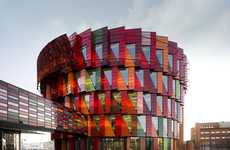
This Vilhelmsro School in Denmark Features Green Technology
The futuristic design of the Vilhelmsro School in Denmark features environmentally efficient elements. Proposed by Bjarke Ingels Group, the educational institute is topped with sloping green roofs which are an integral part of the school.
Based on green building techniques, Vilhelmsro School's proposed design utilizes the maximum benefits of sustainable energy, offering a more natural surrounding for students.
Implications - Sustainability is the future of design and architecture, especially in a world that is increasingly beset by climate change. Modern consumers are more mindful of the state of the planet than ever before, and as such, companies have to make sure their latest products and designs are targeted towards this critical priority.
Based on green building techniques, Vilhelmsro School's proposed design utilizes the maximum benefits of sustainable energy, offering a more natural surrounding for students.
Implications - Sustainability is the future of design and architecture, especially in a world that is increasingly beset by climate change. Modern consumers are more mindful of the state of the planet than ever before, and as such, companies have to make sure their latest products and designs are targeted towards this critical priority.
Trend Themes
1. Green Building Materials - Companies can invest in the development and utilization of sustainable materials for their buildings to reduce their carbon footprint and appeal to eco-conscious consumers.
2. Eco-friendly Architecture - Design firms can incorporate more environmentally efficient elements into their building plans to offer natural surroundings and conserve energy.
3. Sustainable Education Centers - Schools and educational institutions can prioritize integrating sustainability into their buildings to provide students with a green and eco-conscious learning environment.
Industry Implications
1. Construction - The construction industry can embrace green building techniques and materials, offering eco-friendly alternatives to traditional construction methods.
2. Architecture - Architectural firms have the opportunity to pioneer new designs that integrate sustainable elements and reduce the carbon footprint of their buildings.
3. Education - Educational institutions can prioritize the integration of sustainable and eco-conscious building designs into their facilities to educate students on the importance and benefits of environmental conservation.
2.1
Score
Popularity
Activity
Freshness























